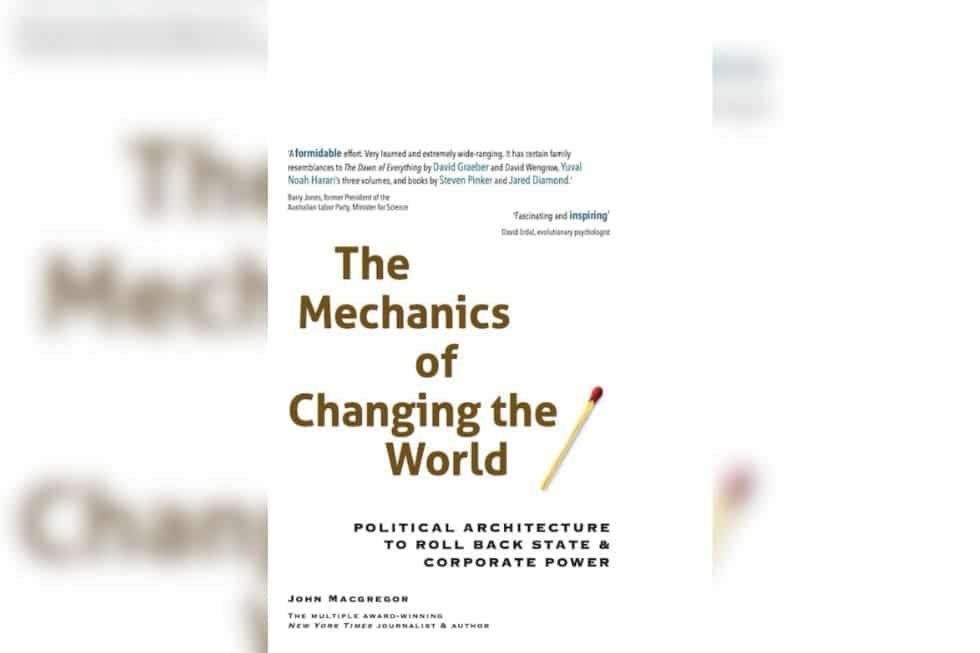John Macgregor’s The Mechanics of Changing the World is a ten-part, comprehensive analysis of the shortcomings of current democratic structures. As the global public grows increasingly disillusioned with current forms of democracy, books such as this one are necessary for understanding how the public might enact radical change. This is what makes The Mechanics of Changing the World convincing and compelling: it bridges the gap between problem and solution. It offers insight into both our disillusionment and what we can do about it.
Balancing insight and engagement in complex analysis
The book’s strength lies in its balance between a clear, empirical tone and sympathetic humor. Macgregor’s analysis is complex, yet well-managed; the argument effortlessly flows from one point to another without losing the reader’s attention. Macgregor presents a difficult subject in a way that is both entertaining and comprehensive. His prose has a way of captivating — even during data-heavy sections.
Despite the book’s obvious length, I caution readers not to take Macgregor’s suggestion (“When the mood strikes, skim!”). “Attacking [challenges] singly,” Macgregor writes, “has not gone well.” I took this to heart as a reader. Each of the ten parts contributes a wide, unique array of insightful topics to the three goals (and thus the overall purpose) of the book.
How democracy declined, how to fix it and how to make it happen
The first goal, to explore the reason for democratic decline, is incredibly detailed. Macgregor takes us through the history of democracy from early humans to the Greek demos. This is a clue into the structure of the rest of the book: Macgregor is determined to make sure the audience understands the context behind an event before offering analysis. It’s effective – readers won’t be missing context regarding certain events, policies or laws.
The second goal is to present solutions for the current democratic deficit. Parts three and nine are the most solution-driven sections, but I found that most parts offer well-detailed and empirically supported suggestions for fixing the current democracy. Never once does Macgregor fail to support the “dynamic constitutional experiments” he explores. His ideas are logical — and achievable. This, in my opinion, is the most important aspect of the solutions this book offers. The Mechanics of Changing the World urges us to realize that change is not unattainable.
That brings us to the third goal: to describe how to implement these solutions effectively, both in terms of cost and collaboration. The book doesn’t shy away from the hard question of implementation, a factor many analyses often refuse to touch upon. To quote Macgregor: “Without the means to implement, the best paper reforms would come to nothing.” The Mechanics of Changing the World is not a laundry list of solutions. Not only that, but the forms of implementation are largely grassroots movements, harkening back to the second goal of presenting feasible solutions.
Empowering citizens to ignite democratic change
The argument and case for implementation could be strengthened even further, perhaps, with suggestions for what to do right now. This is not to say that the book doesn’t explore how citizens can participate in building up democracy — it does, and quite effectively. What I mean to say is, what actions can citizens take to spark a widespread desire for democratic change?
That being said, this book will undoubtedly rouse the desire for action in its readers. I found my own feelings of disillusionment reflected back at me, only this time in a way I could understand. Even if readers take Macgregor’s advice to skim, they would undoubtedly gain an increased interest in the failings of our current democratic structures. This is the broad purpose of The Mechanics of Changing the World — this book is an open invitation to peel back the layers of democracy and question what makes it tick.
[Kaitlyn Diana edited this piece.]
The views expressed in this article are the author’s own and do not necessarily reflect Fair Observer’s editorial policy.
Support Fair Observer
We rely on your support for our independence, diversity and quality.
For more than 10 years, Fair Observer has been free, fair and independent. No billionaire owns us, no advertisers control us. We are a reader-supported nonprofit. Unlike many other publications, we keep our content free for readers regardless of where they live or whether they can afford to pay. We have no paywalls and no ads.
In the post-truth era of fake news, echo chambers and filter bubbles, we publish a plurality of perspectives from around the world. Anyone can publish with us, but everyone goes through a rigorous editorial process. So, you get fact-checked, well-reasoned content instead of noise.
We publish 3,000+ voices from 90+ countries. We also conduct education and training programs
on subjects ranging from digital media and journalism to writing and critical thinking. This
doesn’t come cheap. Servers, editors, trainers and web developers cost
money.
Please consider supporting us on a regular basis as a recurring donor or a
sustaining member.
Will you support FO’s journalism?
We rely on your support for our independence, diversity and quality.








Comment